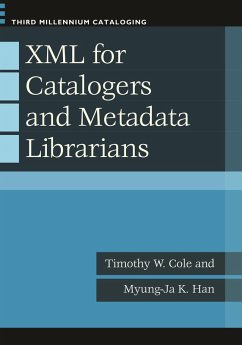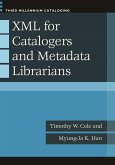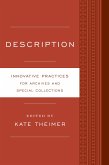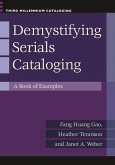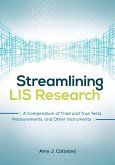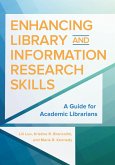40,95 €
40,95 €
inkl. MwSt.
Sofort per Download lieferbar

20 °P sammeln
40,95 €
Als Download kaufen

40,95 €
inkl. MwSt.
Sofort per Download lieferbar

20 °P sammeln
Jetzt verschenken
Alle Infos zum eBook verschenken
40,95 €
inkl. MwSt.
Sofort per Download lieferbar
Alle Infos zum eBook verschenken

20 °P sammeln
- Format: ePub
- Merkliste
- Auf die Merkliste
- Bewerten Bewerten
- Teilen
- Produkt teilen
- Produkterinnerung
- Produkterinnerung

Bitte loggen Sie sich zunächst in Ihr Kundenkonto ein oder registrieren Sie sich bei
bücher.de, um das eBook-Abo tolino select nutzen zu können.
Hier können Sie sich einloggen
Hier können Sie sich einloggen
Sie sind bereits eingeloggt. Klicken Sie auf 2. tolino select Abo, um fortzufahren.

Bitte loggen Sie sich zunächst in Ihr Kundenkonto ein oder registrieren Sie sich bei bücher.de, um das eBook-Abo tolino select nutzen zu können.
This book provides a foundation of knowledge for catalogers, metadata librarians, and library school students on the Extensible Markup Language (XML)-one of the most commonly listed qualifications in today's cataloger and metadata librarian job postings. How are today's librarians to manage and describe the ever-expanding volumes of resources, in both digital and print formats? The use of XML in cataloging and metadata workflows can improve metadata quality, the consistency of cataloging workflows, and adherence to standards. This book is intended to enable current and future catalogers and…mehr
- Geräte: eReader
- mit Kopierschutz
- eBook Hilfe
- Größe: 4.67MB
Andere Kunden interessierten sich auch für
![XML for Catalogers and Metadata Librarians (eBook, PDF) XML for Catalogers and Metadata Librarians (eBook, PDF)]() Timothy W. ColeXML for Catalogers and Metadata Librarians (eBook, PDF)40,95 €
Timothy W. ColeXML for Catalogers and Metadata Librarians (eBook, PDF)40,95 €![Organizing Library Collections (eBook, ePUB) Organizing Library Collections (eBook, ePUB)]() Gretchen L. HoffmanOrganizing Library Collections (eBook, ePUB)40,95 €
Gretchen L. HoffmanOrganizing Library Collections (eBook, ePUB)40,95 €![Linking Picture Book Biographies to National Content Standards (eBook, ePUB) Linking Picture Book Biographies to National Content Standards (eBook, ePUB)]() Liz DeskinsLinking Picture Book Biographies to National Content Standards (eBook, ePUB)31,95 €
Liz DeskinsLinking Picture Book Biographies to National Content Standards (eBook, ePUB)31,95 €![Description (eBook, ePUB) Description (eBook, ePUB)]() Description (eBook, ePUB)57,95 €
Description (eBook, ePUB)57,95 €![Demystifying Serials Cataloging (eBook, ePUB) Demystifying Serials Cataloging (eBook, ePUB)]() Fang Huang GaoDemystifying Serials Cataloging (eBook, ePUB)43,95 €
Fang Huang GaoDemystifying Serials Cataloging (eBook, ePUB)43,95 €![Streamlining LIS Research (eBook, ePUB) Streamlining LIS Research (eBook, ePUB)]() Amy J. CatalanoStreamlining LIS Research (eBook, ePUB)50,95 €
Amy J. CatalanoStreamlining LIS Research (eBook, ePUB)50,95 €![Enhancing Library and Information Research Skills (eBook, ePUB) Enhancing Library and Information Research Skills (eBook, ePUB)]() Lili LuoEnhancing Library and Information Research Skills (eBook, ePUB)43,95 €
Lili LuoEnhancing Library and Information Research Skills (eBook, ePUB)43,95 €-
-
-
This book provides a foundation of knowledge for catalogers, metadata librarians, and library school students on the Extensible Markup Language (XML)-one of the most commonly listed qualifications in today's cataloger and metadata librarian job postings. How are today's librarians to manage and describe the ever-expanding volumes of resources, in both digital and print formats? The use of XML in cataloging and metadata workflows can improve metadata quality, the consistency of cataloging workflows, and adherence to standards. This book is intended to enable current and future catalogers and metadata librarians to progress beyond a bare surface-level acquaintance with XML, thereby enabling them to integrate XML technologies more fully into their cataloging workflows. Building on the wealth of work on library descriptive practices, cataloging, and metadata, XML for Catalogers and Metadata Librarians explores the use of XML to serialize, process, share, and manage library catalog and metadata records. The authors' expert treatment of the topic is written to be accessible to those with little or no prior practical knowledge of or experience with how XML is used. Readers will gain an educated appreciation of the nuances of XML and grasp the benefit of more advanced and complex XML techniques as applied to applications relevant to catalogers and metadata librarians.
Produktdetails
- Produktdetails
- Verlag: Bloomsbury eBooks US
- Seitenzahl: 404
- Altersempfehlung: ab 7 Jahre
- Erscheinungstermin: 23. Mai 2013
- Englisch
- ISBN-13: 9798216169215
- Artikelnr.: 68167808
- Verlag: Bloomsbury eBooks US
- Seitenzahl: 404
- Altersempfehlung: ab 7 Jahre
- Erscheinungstermin: 23. Mai 2013
- Englisch
- ISBN-13: 9798216169215
- Artikelnr.: 68167808
- Herstellerkennzeichnung Die Herstellerinformationen sind derzeit nicht verfügbar.
Timothy W. Cole is mathematics and digital content access librarian; professor of library and information science; and professor, university library, at the University of Illinois at Urbana-Champaign.
Myung-Ja K. Han is metadata librarian and assistant professor, university library at the University of Illinois at Urbana-Champaign. She has published papers on metadata quality and bibliographic control in various journals.
Myung-Ja K. Han is metadata librarian and assistant professor, university library at the University of Illinois at Urbana-Champaign. She has published papers on metadata quality and bibliographic control in various journals.
Preface
PART I INTRODUCTION AND OVERVIEW
Chapter 1 XML: What Is It?
Many Definitions of XML
XML Elements As Content Objects
The Basic Markup Rules of XML
OHCO: Practical Considerations
How the Rest of This Book Is Organized
Tools for Creating, Viewing, and Editing XML Metadata
Questions and Topics for Discussion
Suggestions for Exercises
Notes
References
Chapter 2 XML: Why It Is Important to Catalogers and Metadata Librarians
Trends in Bibliographic Control and Descriptive Cataloging
Changing Job Descriptions
Looking Ahead
Questions and Topics for Discussion
Suggestions for Exercises
Notes
References
Chapter 3 XML: Core Syntax and Grammar
Character Data, White Space, and Entities
Element Types
Attributes
Processing Instructions, Declarations, CDATA, and Comments
Well-Formed XML versus Valid XML
Schemas and Namespaces
Summary
Questions and Topics for Discussion
Suggestions for Exercises
Notes
PART II STRUCTURED METADATA IN XML
Chapter 4 MARCXML: Library Catalog Records as Structured Data
Traditional MARC
MARC SGML
MARCXML
Case Study 4.1: Creating an XML Snapshot of a Library Catalog for Google
Case Study 4.2: Creating MARCXML Records for the HathiTrust
Summary
Questions and Topics for Discussion
Suggestions for Exercises
Notes
References
Chapter 5 Other Metadata Standards in XML: Dublin Core, MODS, and ONIX
Working with Other Metadata Standards
Dublin Core in XML
Case Study 5.1: Dublin Core Metadata in CONTENTdm
MODS in XML
Case Study 5.2: Hypatia: A MODS Record Creation and Ingest Tool
ONIX for Books in XML
Case Study 5.3: Integrating ONIX Records into the OPAC
Other Metadata Standards
Questions and Topics for Discussion
Suggestions for Exercises
Notes
References
Chapter 6 Interoperable XML: Namespaces, Shareable Metadata, and
Application Profiles
XML Namespaces
Shareable Metadata
Application Profiles
Case Study 6.1: Creating a Project-Based Application Profile
Case Study 6.2: IMLS DCC Collection Description Application Profile
Observations
Questions and Topics for Discussion
Suggestions for Exercises
Notes
References
PART III AUTHORING AND VALIDATING XML
Chapter 7 Valid XML (Part I): Document Type Definitions
When Well-Formed XML Is Not Enough
Defining an XML Metadata Grammar in a DTD
Syntax and Semantics of DTDs
Case Study 7.1: A DTD for Simple Dublin Core
Questions and Topics for Discussion
Suggestions for Exercises
Notes
References
Chapter 8 Valid XML (Part II): XML Schemas
The Need for Alternatives to XML DTDs
Differences between DTDs and XSDs
W3C XML Schema Definition Language Illustrations
Case Study 8.1: Checking MARCXML Records Using Oxygen and an XSD
Other Schema Languages
Questions and Topics for Discussion
Suggestions for Exercises
Notes
References
Chapter 9 Advanced XML Grammars: Schemas and Namespaces, Uniqueness, and
Keys
Using XML Namespaces and XML Schemas Together
Case Study 9.1: A "Spine" of Metadata for Digitized Emblem Books
Keys, Key References, and Uniqueness Constraints
Case Study 9.2: Creating the DLF Aquifer Asset Action XML Schema
Questions and Topics for Discussion
Suggestions for Exercises
Notes
References
PART IV METADATA CROSSWALKS, XML TRANSFORMATIONS, AND RDF XML
Chapter 10 Transforming XML (Part I): Metadata Crosswalking and XPath
Metadata Crosswalks
Using XPath to Analyze and Navigate XML Metadata Records
XPath Operators and Functions
Summary
Questions and Topics for Discussion
Suggestions for Exercises
Notes
References
Chapter 11 Transforming XML (Part II): Extensible Stylesheet Language for
Transformations
Introduction to XSLT
The Structure of an XSLT Style Sheet
Variables and Parameters in XSLT
Recursion and Advanced Uses of Axes in XSLT
Case Study 11.1: Generating XHTML Splash Page from MARCXML
Case Study 11.2: Creating E-Book Records for Retrospectively Digitized
Books
Summary
Questions and Topics for Discussion
Suggestions for Exercises
Notes
References
Chapter 12 RDF and XML: Serializing Triples (Statements) in XML
An Introduction to RDF in XML
RDF Schema
RDFa
Case Study 12.1: RDFa from MARCXML and Dublin Core
Questions and Topics for Discussion
Suggestions for Exercises
Notes
References
Chapter 13 XML and the Future of Descriptive Cataloging
Changes and Challenges
Exploiting XML in Library Work Flows
Case Study 13.1: Emblematica Online
Closing Thoughts
Questions and Topics for Discussion
Suggestions for Exercises
Notes
References
Glossary of XML Terms
Index
PART I INTRODUCTION AND OVERVIEW
Chapter 1 XML: What Is It?
Many Definitions of XML
XML Elements As Content Objects
The Basic Markup Rules of XML
OHCO: Practical Considerations
How the Rest of This Book Is Organized
Tools for Creating, Viewing, and Editing XML Metadata
Questions and Topics for Discussion
Suggestions for Exercises
Notes
References
Chapter 2 XML: Why It Is Important to Catalogers and Metadata Librarians
Trends in Bibliographic Control and Descriptive Cataloging
Changing Job Descriptions
Looking Ahead
Questions and Topics for Discussion
Suggestions for Exercises
Notes
References
Chapter 3 XML: Core Syntax and Grammar
Character Data, White Space, and Entities
Element Types
Attributes
Processing Instructions, Declarations, CDATA, and Comments
Well-Formed XML versus Valid XML
Schemas and Namespaces
Summary
Questions and Topics for Discussion
Suggestions for Exercises
Notes
PART II STRUCTURED METADATA IN XML
Chapter 4 MARCXML: Library Catalog Records as Structured Data
Traditional MARC
MARC SGML
MARCXML
Case Study 4.1: Creating an XML Snapshot of a Library Catalog for Google
Case Study 4.2: Creating MARCXML Records for the HathiTrust
Summary
Questions and Topics for Discussion
Suggestions for Exercises
Notes
References
Chapter 5 Other Metadata Standards in XML: Dublin Core, MODS, and ONIX
Working with Other Metadata Standards
Dublin Core in XML
Case Study 5.1: Dublin Core Metadata in CONTENTdm
MODS in XML
Case Study 5.2: Hypatia: A MODS Record Creation and Ingest Tool
ONIX for Books in XML
Case Study 5.3: Integrating ONIX Records into the OPAC
Other Metadata Standards
Questions and Topics for Discussion
Suggestions for Exercises
Notes
References
Chapter 6 Interoperable XML: Namespaces, Shareable Metadata, and
Application Profiles
XML Namespaces
Shareable Metadata
Application Profiles
Case Study 6.1: Creating a Project-Based Application Profile
Case Study 6.2: IMLS DCC Collection Description Application Profile
Observations
Questions and Topics for Discussion
Suggestions for Exercises
Notes
References
PART III AUTHORING AND VALIDATING XML
Chapter 7 Valid XML (Part I): Document Type Definitions
When Well-Formed XML Is Not Enough
Defining an XML Metadata Grammar in a DTD
Syntax and Semantics of DTDs
Case Study 7.1: A DTD for Simple Dublin Core
Questions and Topics for Discussion
Suggestions for Exercises
Notes
References
Chapter 8 Valid XML (Part II): XML Schemas
The Need for Alternatives to XML DTDs
Differences between DTDs and XSDs
W3C XML Schema Definition Language Illustrations
Case Study 8.1: Checking MARCXML Records Using Oxygen and an XSD
Other Schema Languages
Questions and Topics for Discussion
Suggestions for Exercises
Notes
References
Chapter 9 Advanced XML Grammars: Schemas and Namespaces, Uniqueness, and
Keys
Using XML Namespaces and XML Schemas Together
Case Study 9.1: A "Spine" of Metadata for Digitized Emblem Books
Keys, Key References, and Uniqueness Constraints
Case Study 9.2: Creating the DLF Aquifer Asset Action XML Schema
Questions and Topics for Discussion
Suggestions for Exercises
Notes
References
PART IV METADATA CROSSWALKS, XML TRANSFORMATIONS, AND RDF XML
Chapter 10 Transforming XML (Part I): Metadata Crosswalking and XPath
Metadata Crosswalks
Using XPath to Analyze and Navigate XML Metadata Records
XPath Operators and Functions
Summary
Questions and Topics for Discussion
Suggestions for Exercises
Notes
References
Chapter 11 Transforming XML (Part II): Extensible Stylesheet Language for
Transformations
Introduction to XSLT
The Structure of an XSLT Style Sheet
Variables and Parameters in XSLT
Recursion and Advanced Uses of Axes in XSLT
Case Study 11.1: Generating XHTML Splash Page from MARCXML
Case Study 11.2: Creating E-Book Records for Retrospectively Digitized
Books
Summary
Questions and Topics for Discussion
Suggestions for Exercises
Notes
References
Chapter 12 RDF and XML: Serializing Triples (Statements) in XML
An Introduction to RDF in XML
RDF Schema
RDFa
Case Study 12.1: RDFa from MARCXML and Dublin Core
Questions and Topics for Discussion
Suggestions for Exercises
Notes
References
Chapter 13 XML and the Future of Descriptive Cataloging
Changes and Challenges
Exploiting XML in Library Work Flows
Case Study 13.1: Emblematica Online
Closing Thoughts
Questions and Topics for Discussion
Suggestions for Exercises
Notes
References
Glossary of XML Terms
Index
Preface
PART I INTRODUCTION AND OVERVIEW
Chapter 1 XML: What Is It?
Many Definitions of XML
XML Elements As Content Objects
The Basic Markup Rules of XML
OHCO: Practical Considerations
How the Rest of This Book Is Organized
Tools for Creating, Viewing, and Editing XML Metadata
Questions and Topics for Discussion
Suggestions for Exercises
Notes
References
Chapter 2 XML: Why It Is Important to Catalogers and Metadata Librarians
Trends in Bibliographic Control and Descriptive Cataloging
Changing Job Descriptions
Looking Ahead
Questions and Topics for Discussion
Suggestions for Exercises
Notes
References
Chapter 3 XML: Core Syntax and Grammar
Character Data, White Space, and Entities
Element Types
Attributes
Processing Instructions, Declarations, CDATA, and Comments
Well-Formed XML versus Valid XML
Schemas and Namespaces
Summary
Questions and Topics for Discussion
Suggestions for Exercises
Notes
PART II STRUCTURED METADATA IN XML
Chapter 4 MARCXML: Library Catalog Records as Structured Data
Traditional MARC
MARC SGML
MARCXML
Case Study 4.1: Creating an XML Snapshot of a Library Catalog for Google
Case Study 4.2: Creating MARCXML Records for the HathiTrust
Summary
Questions and Topics for Discussion
Suggestions for Exercises
Notes
References
Chapter 5 Other Metadata Standards in XML: Dublin Core, MODS, and ONIX
Working with Other Metadata Standards
Dublin Core in XML
Case Study 5.1: Dublin Core Metadata in CONTENTdm
MODS in XML
Case Study 5.2: Hypatia: A MODS Record Creation and Ingest Tool
ONIX for Books in XML
Case Study 5.3: Integrating ONIX Records into the OPAC
Other Metadata Standards
Questions and Topics for Discussion
Suggestions for Exercises
Notes
References
Chapter 6 Interoperable XML: Namespaces, Shareable Metadata, and
Application Profiles
XML Namespaces
Shareable Metadata
Application Profiles
Case Study 6.1: Creating a Project-Based Application Profile
Case Study 6.2: IMLS DCC Collection Description Application Profile
Observations
Questions and Topics for Discussion
Suggestions for Exercises
Notes
References
PART III AUTHORING AND VALIDATING XML
Chapter 7 Valid XML (Part I): Document Type Definitions
When Well-Formed XML Is Not Enough
Defining an XML Metadata Grammar in a DTD
Syntax and Semantics of DTDs
Case Study 7.1: A DTD for Simple Dublin Core
Questions and Topics for Discussion
Suggestions for Exercises
Notes
References
Chapter 8 Valid XML (Part II): XML Schemas
The Need for Alternatives to XML DTDs
Differences between DTDs and XSDs
W3C XML Schema Definition Language Illustrations
Case Study 8.1: Checking MARCXML Records Using Oxygen and an XSD
Other Schema Languages
Questions and Topics for Discussion
Suggestions for Exercises
Notes
References
Chapter 9 Advanced XML Grammars: Schemas and Namespaces, Uniqueness, and
Keys
Using XML Namespaces and XML Schemas Together
Case Study 9.1: A "Spine" of Metadata for Digitized Emblem Books
Keys, Key References, and Uniqueness Constraints
Case Study 9.2: Creating the DLF Aquifer Asset Action XML Schema
Questions and Topics for Discussion
Suggestions for Exercises
Notes
References
PART IV METADATA CROSSWALKS, XML TRANSFORMATIONS, AND RDF XML
Chapter 10 Transforming XML (Part I): Metadata Crosswalking and XPath
Metadata Crosswalks
Using XPath to Analyze and Navigate XML Metadata Records
XPath Operators and Functions
Summary
Questions and Topics for Discussion
Suggestions for Exercises
Notes
References
Chapter 11 Transforming XML (Part II): Extensible Stylesheet Language for
Transformations
Introduction to XSLT
The Structure of an XSLT Style Sheet
Variables and Parameters in XSLT
Recursion and Advanced Uses of Axes in XSLT
Case Study 11.1: Generating XHTML Splash Page from MARCXML
Case Study 11.2: Creating E-Book Records for Retrospectively Digitized
Books
Summary
Questions and Topics for Discussion
Suggestions for Exercises
Notes
References
Chapter 12 RDF and XML: Serializing Triples (Statements) in XML
An Introduction to RDF in XML
RDF Schema
RDFa
Case Study 12.1: RDFa from MARCXML and Dublin Core
Questions and Topics for Discussion
Suggestions for Exercises
Notes
References
Chapter 13 XML and the Future of Descriptive Cataloging
Changes and Challenges
Exploiting XML in Library Work Flows
Case Study 13.1: Emblematica Online
Closing Thoughts
Questions and Topics for Discussion
Suggestions for Exercises
Notes
References
Glossary of XML Terms
Index
PART I INTRODUCTION AND OVERVIEW
Chapter 1 XML: What Is It?
Many Definitions of XML
XML Elements As Content Objects
The Basic Markup Rules of XML
OHCO: Practical Considerations
How the Rest of This Book Is Organized
Tools for Creating, Viewing, and Editing XML Metadata
Questions and Topics for Discussion
Suggestions for Exercises
Notes
References
Chapter 2 XML: Why It Is Important to Catalogers and Metadata Librarians
Trends in Bibliographic Control and Descriptive Cataloging
Changing Job Descriptions
Looking Ahead
Questions and Topics for Discussion
Suggestions for Exercises
Notes
References
Chapter 3 XML: Core Syntax and Grammar
Character Data, White Space, and Entities
Element Types
Attributes
Processing Instructions, Declarations, CDATA, and Comments
Well-Formed XML versus Valid XML
Schemas and Namespaces
Summary
Questions and Topics for Discussion
Suggestions for Exercises
Notes
PART II STRUCTURED METADATA IN XML
Chapter 4 MARCXML: Library Catalog Records as Structured Data
Traditional MARC
MARC SGML
MARCXML
Case Study 4.1: Creating an XML Snapshot of a Library Catalog for Google
Case Study 4.2: Creating MARCXML Records for the HathiTrust
Summary
Questions and Topics for Discussion
Suggestions for Exercises
Notes
References
Chapter 5 Other Metadata Standards in XML: Dublin Core, MODS, and ONIX
Working with Other Metadata Standards
Dublin Core in XML
Case Study 5.1: Dublin Core Metadata in CONTENTdm
MODS in XML
Case Study 5.2: Hypatia: A MODS Record Creation and Ingest Tool
ONIX for Books in XML
Case Study 5.3: Integrating ONIX Records into the OPAC
Other Metadata Standards
Questions and Topics for Discussion
Suggestions for Exercises
Notes
References
Chapter 6 Interoperable XML: Namespaces, Shareable Metadata, and
Application Profiles
XML Namespaces
Shareable Metadata
Application Profiles
Case Study 6.1: Creating a Project-Based Application Profile
Case Study 6.2: IMLS DCC Collection Description Application Profile
Observations
Questions and Topics for Discussion
Suggestions for Exercises
Notes
References
PART III AUTHORING AND VALIDATING XML
Chapter 7 Valid XML (Part I): Document Type Definitions
When Well-Formed XML Is Not Enough
Defining an XML Metadata Grammar in a DTD
Syntax and Semantics of DTDs
Case Study 7.1: A DTD for Simple Dublin Core
Questions and Topics for Discussion
Suggestions for Exercises
Notes
References
Chapter 8 Valid XML (Part II): XML Schemas
The Need for Alternatives to XML DTDs
Differences between DTDs and XSDs
W3C XML Schema Definition Language Illustrations
Case Study 8.1: Checking MARCXML Records Using Oxygen and an XSD
Other Schema Languages
Questions and Topics for Discussion
Suggestions for Exercises
Notes
References
Chapter 9 Advanced XML Grammars: Schemas and Namespaces, Uniqueness, and
Keys
Using XML Namespaces and XML Schemas Together
Case Study 9.1: A "Spine" of Metadata for Digitized Emblem Books
Keys, Key References, and Uniqueness Constraints
Case Study 9.2: Creating the DLF Aquifer Asset Action XML Schema
Questions and Topics for Discussion
Suggestions for Exercises
Notes
References
PART IV METADATA CROSSWALKS, XML TRANSFORMATIONS, AND RDF XML
Chapter 10 Transforming XML (Part I): Metadata Crosswalking and XPath
Metadata Crosswalks
Using XPath to Analyze and Navigate XML Metadata Records
XPath Operators and Functions
Summary
Questions and Topics for Discussion
Suggestions for Exercises
Notes
References
Chapter 11 Transforming XML (Part II): Extensible Stylesheet Language for
Transformations
Introduction to XSLT
The Structure of an XSLT Style Sheet
Variables and Parameters in XSLT
Recursion and Advanced Uses of Axes in XSLT
Case Study 11.1: Generating XHTML Splash Page from MARCXML
Case Study 11.2: Creating E-Book Records for Retrospectively Digitized
Books
Summary
Questions and Topics for Discussion
Suggestions for Exercises
Notes
References
Chapter 12 RDF and XML: Serializing Triples (Statements) in XML
An Introduction to RDF in XML
RDF Schema
RDFa
Case Study 12.1: RDFa from MARCXML and Dublin Core
Questions and Topics for Discussion
Suggestions for Exercises
Notes
References
Chapter 13 XML and the Future of Descriptive Cataloging
Changes and Challenges
Exploiting XML in Library Work Flows
Case Study 13.1: Emblematica Online
Closing Thoughts
Questions and Topics for Discussion
Suggestions for Exercises
Notes
References
Glossary of XML Terms
Index
